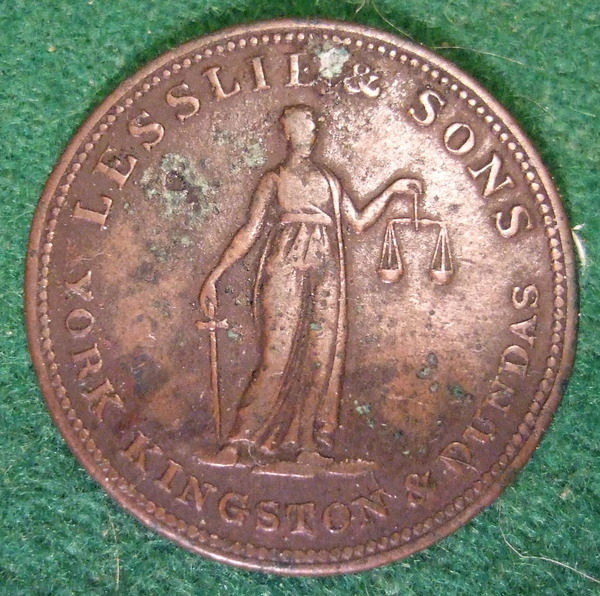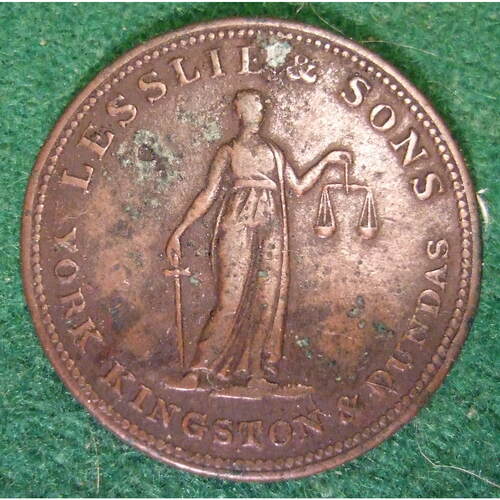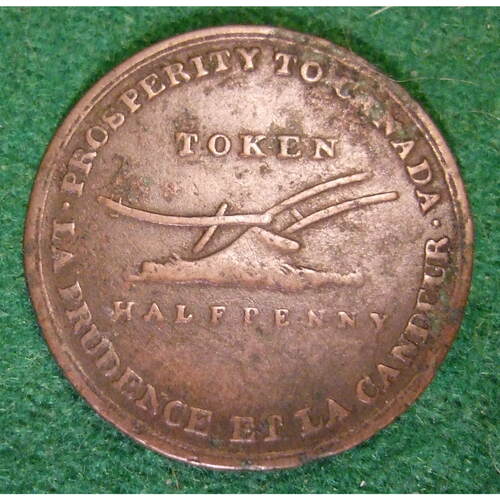
Source: Courtesy of Wikimedia Commons
LESSLIE, JAMES, merchant, publisher, and politician; b. 22 Nov. 1802 in Dundee, Scotland, the third of 12 children of Edward Lesslie and Grace Watson; d. 19 April 1885 at Eglinton (now part of Toronto), Ont.
James Lesslie’s father was a well-to-do stationer, bookbinder, and bookseller in Dundee, and was able to provide his offspring with a good education. When, in 1819, Edward decided to emigrate to Canada to open a new business that would offer greater opportunities to his large family, his funds allowed him to plan to charter a brig to carry them and his stock. First, however, he sent out his second son, John, with a supply of goods to launch the enterprise. Arriving in 1820, John chose the town of York (Toronto) as the best business site in fast-arising Upper Canada. He had come out on the same ship as William Lyon Mackenzie*, also from Dundee and an acquaintance of his father, and the two young men began a general store together, in a building opposite St James’ Church, which pioneered at York in selling books and drugs – the profit from the former going to Lesslie, the latter to Mackenzie. The following year they opened an additional store, Mackenzie and Lesslie, at the prosperous milling village of Dundas, dealing again in drugs, books, hardware, and general merchandise.
Meanwhile, ill health delayed the main Lesslie immigration. Consequently, Edward’s third son, James, then 19, was sent on the chartered brig in charge of the family’s goods and supplies as well as his 17-year-old sister and his 11-year-old brother, Charles. They landed at Quebec in the fall of 1822, after a 70-day passage through heavy gales. Since the stock he had brought was not now needed at York, James was advised to open a shop at Kingston instead. He did so, and ran the Kingston store for the next four years. By that time his parents and the rest of the family had arrived and settled in Dundas, where Mackenzie and John Lesslie had dissolved their partnership early in 1823, the former taking his share of the goods and moving to Queenston to establish a store there. The Dundas establishment then fell largely to the direction of another Lesslie brother, William, slightly younger than James. But all three stores, John’s in York, James’s in Kingston, and William’s in Dundas, operated under the name of Lesslie and Sons.
This three-branch undertaking even had its own “coinage” struck in Birmingham, England, in the form of copper tokens in halfpenny and twopenny values, as was frequent practice in a day of inadequate currency in the colony and mongrel, dubious coins in circulation. Lesslie and Sons thrived with the expanding settlement boom of the 1820s, and in York they moved to larger quarters on King Street. There were also shifts in management. John took over the Dundas store and William the one in Kingston, while from 1826 James was in control at York – clearly still the main enterprise – assisted by his father and the youngest Lesslie brother, Joseph. Only the eldest brother, Edward, does not seem to have been closely engaged in the family business and presumably was farming. In 1828 Edward Sr died, but the firm continued under the same title. In York, indeed, with the growing specialization of increased trade, Lesslie and Sons became designated “Stationers and Druggists”; one side of their large brick store was mainly given over to books and stationery, the other to pharmaceuticals.
As the leading figure in this significant business, James Lesslie was becoming affluent and prominent. From 1829 he gradually acquired highly valuable real estate especially in the emerging centre of the town, some of which remained with his heirs till the 1950s. He was also entering into civic-minded activities. In 1831 he played a major part in establishing the mechanics’ institute. Joseph Bates, an English watchmaker who was a tenant of Lesslie and Sons and who had been a member of the original London society, was eager to transplant to Canada this scheme for educating and elevating the working classes. James Lesslie heartily approved, issued circulars for a founding meeting, and worked actively thereafter to promote the institute and secure it a parliamentary grant. In 1834, when York was incorporated as the city of Toronto, he ran in the first civic elections, and was returned as alderman for St David’s Ward, as was William Lyon Mackenzie. In 1836, he was one of a small key group of Toronto Reformers who pressed for and obtained a House of Industry to deal with the increasing problems of poverty in the swelling city.
James Lesslie was assuredly a Reformer, almost by definition. An earnest Scots Baptist who saw any “state Religion” as a “horrible delusion,” he was an aspiring business exponent of self-help and progress, a well-read, reform-minded bookseller who looked for an enlightened democratic public to bestow “rational freedom upon our land,” and a family friend of William Lyon Mackenzie to boot. James, in the rising political clashes of the 1830s in Upper Canada, quite naturally upheld civil liberty and religious equality, and opposed what he viewed as the despotic powers of hidebound Toryism or the unjust pretensions of a privileged Church of England. A close supporter of Mackenzie, Lesslie seconded his nomination as mayor in Toronto’s first civic administration of 1834. He also became president of the Canadian Alliance, founded late in 1834 with Mackenzie as its corresponding secretary, which was intended to spread more advanced Reform ideas, such as a written, elective constitution on the American model, the secret ballot, the abolition of all monopolies, and the full separation of church and state.
Then in 1835 Lesslie was instrumental in the establishment of the Bank of the People, a Reform response to the government-associated Bank of Upper Canada, being named its first cashier (general manager) and shortly afterwards succeeding the first president, John Rolph*, when Francis Hincks was appointed cashier. Under good management the “People’s Bank,” despite having no limited liability, weathered the financial crises of 1836 without having to suspend payments like the other Toronto banks. Yet its limited capital and unlimited risk were drawbacks which brought about its sale to the Bank of Montreal in 1840, all its stockholders having been paid off, as Lesslie could proudly record.
In the mean time, political discord in Upper Canada had led to the brief outburst of rebellion in 1837, which unhappily involved James Lesslie. He had gained considerable public exposure (and, in Tory eyes, notoriety) by this time, as an ardent member of the radical wing of the Reform movement, that associated with Mackenzie and Peter Perry*, rather than the moderates linked with William Warren Baldwin* and his son Robert*. For instance, in 1836 James and another advanced Reformer, Jesse Ketchum*, had delivered to Lieutenant Governor Sir Francis Bond Head* a decidedly “stinging” Reform address, a rejoinder to the governor’s no less sharp answer to an initial address from Toronto citizens. While radical in leanings, however, Lesslie was in no way implicated in the rebellion itself and repudiated the appeal to force. Nevertheless, in the turmoil that accompanied the crushing of the Yonge Street rising, whether impelled by anger, suspicion, or plain vengefulness, an armed loyal band descended on James’s house on 8 Dec. 1837, arrested both him and his brother William, and thrust them in jail. There they were held for 13 days, without warrant, examination, or appeal to habeas corpus. When finally released, still uncharged, they were bound over to keep the peace on sureties of £500 each. A hotly indignant petition by James and William was carried to the imperial parliament and to the Colonial Office, but accomplished little more than to relieve their feelings.
Indeed, in the period of harassment and frustration which followed the rebellion many despondent radicals grew ready to give up Canada and move to the United States. For this purpose the Mississippi Emigration Society was formed in Toronto early in 1838. Three delegates – two Reform members of the assembly, Peter Perry and Thomas Parke*, and James Lesslie – were selected to choose and negotiate for land to settle. Near Davenport, Iowa, they found a desirable tract, although James fell ill from the ordeals of a long journey into a wilderness of swamps and prairie. On their return, however, they learned of the mission to Canada of Lord Durham [Lambton*], a new, liberal governor general who offered high promise of reforming the colonial political system. James decided to stay. In fact, the Mississippi venture lost impetus, though some did emigrate, including his brother Charles, who spent the rest of his days at Davenport.
In the next few years, James Lesslie busied himself with the campaign by a reinvigorated, though more moderate, Reform movement for responsible government, a campaign which found strong endorsement in the recommendations of Durham’s report in 1839, and which was led by Robert Baldwin with the vigorous backing of Francis Hincks’s new party organ, the Toronto Examiner. At the same time the Lesslie business went on growing and changing. The old partnership was dissolved; John retained the Dundas store; William merged his Kingston business into James’s at Toronto; and in 1841, now under the name of Lesslie Brothers, the Toronto firm built and occupied a fine brick store. Here Joseph would also work, but the enterprise really remained with James, especially after William died in 1843.
By then, moreover, a very different undertaking had been added. In 1842 Francis Hincks gave up the Examiner on entering the government. Lesslie took it over, and published it from the rear of his extensive store buildings. It was not a strange departure for him. Well-versed in public affairs, and a bookseller linked to the realm of popular publishing, he was only doing what William Lyon Mackenzie had done earlier when he had moved into journalism; and James had every reason to want to keep the influential Reform journal going. Still, he also had a sizeable commercial business as well as job-printing activities to manage. Joseph helped as assistant editor for a time, but it was not till 1846, when James obtained the services of a bright young English immigrant, Charles Lindsey*, as editor, that he might feel running the Examiner was no longer a problem.
By then, his journal faced a different sort of problem, sharpening competition from another rising Toronto Reform paper, the Globe, founded by George Brown* in 1844. Moreover, this ably managed journal had the backing of the leaders of Baldwin’s party. When the Reformers won power in 1848 under Baldwin and Louis-Hippolyte La Fontaine*, the Globe became the recognized ministerial organ for Upper Canada, and the older Examiner was shunted to the side. Perhaps Lesslie’s erstwhile radical reputation had helped shape the decision of the ascendant Baldwin moderates in the party. At any rate, his radical sentiments now markedly revived, both in the hope of pushing Reform achievements still further and in resentment of the Baldwinites who were leaving true “Old” Reformers out in the cold. This attitude was expressed in his paper, which moved on through 1849 from minor quarrelling with the Globe and the ministerial leaders to outright support of a newly emergent left-wing faction in Upper Canada Reform, soon to be dubbed the Clear Grits.
From the autumn of 1849, Lesslie’s paper began pouring scorn on the inadequate and “aristocratical” achievement of responsible government, calling for a completely democratic and elective constitution on the American model, and also for the abolition of all remaining ties between church and state, notably featured in the clergy reserves of Upper Canada. Lesslie, in fact, entered zealously into a mounting voluntaryist crusade to make all churches purely voluntary bodies with no state aid or recognition. Accordingly, he played a prominent role in founding the Anti-Clergy Reserves Association in Toronto in May 1850. He also worked closely with the group that had shaped the initial, idealistic Clear Grit movement by 1850, which included old radical Reform associates Peter Perry, Malcolm Cameron*, and John Rolph, as well as younger democratic enthusiasts William McDougall* and Charles Clarke*.
But now his Examiner was to be passed on the left as well, when in 1851 McDougall aided by Clarke began the Toronto North American as a more effective popular Clear Grit organ. Then in 1852 the Toronto Leader appeared, a well-funded moderate journal which rapidly became influential and which also lured away the Examiner’s editor, Charles Lindsey (replaced by Daniel Morrison*). Beset by vigorous rivals all around it, Lesslie’s paper thus went into decline during the early 1850s. It was viewed by regular party men as having become rather eccentric, and too inclined to ride its publisher’s disestablishment hobby-horse. Lesslie was probably losing interest in any case, perhaps influenced by the fact that left-wing Reform had now expended much of its zeal and had not produced a democratic Utopia – although, on the other hand, he did see the battle to abolish the reserves achieve success in 1854. After the Reform ministry of Francis Hincks and Augustin-Norbert Morin* fell from power in that year, moreover, the Clear Grits and a more centrist group of Upper Canadian Reformers, who were increasingly influenced by George Brown, began coming back together. One sign of this was the growing party press hegemony built up by the Globe, which was marked further by Lesslie selling the Examiner to Brown in 1855, at a loss of some $8,000 in unpaid subscriptions.
During the 1840s and into the 1850s, Lesslie had continued his involvement in civic affairs in Toronto, notably in regard to non-sectarian public education, a cause close to his heart. In 1843 he was appointed a member of a committee reporting under the city’s board of examiners to design a system of tuition and supervision in Toronto’s common schools devoid of sectarian content or church connection. In 1851 he was elected a school trustee for St David’s Ward, and was an ardent advocate of free schooling in a lively public debate the next year, an aim that was subsequently achieved for the city. He himself, however, was defeated in the school elections of 1853 (the victim of Roman Catholic votes, said the Globe darkly), but served again as trustee from 1854 to 1857. He was also a justice of the peace for the Home District after 1842, and for York County in 1850–51, yet does not seem to have been prominent in this capacity.
In any event, he sold off his stationery, book, and drug business about the time that he closed out the Examiner. Although only in his mid 50s, he was evidently anxious to retire. Hence he took up residence on a 28-acre farm estate north of Toronto at the village of Eglinton, which he had purchased from an old Reform associate, James Hervey Price – and which, incidentally, was adjacent to the site of Montgomery’s Tavern, Mackenzie’s headquarters during the rebellion. Lesslie’s friendship with the leader of that ill-fated enterprise continued through their later lives, both while Mackenzie was in exile and after his return to Canada in the early 1850s. Indeed, in 1859, James served on the committee which drafted the appeal for funds for the “Mackenzie Homestead,” the house on Bond Street, Toronto, given to the erstwhile “Little Rebel” as a public testimonial.
Nevertheless, Lesslie otherwise remained largely in retirement with his books and his farm after moving to Eglinton. He was, however, no recluse. He stayed in close touch with his family, spread from Dundas to Davenport, Iowa; his former political friends were frequent visitors; and he had valuable properties still to attend to in Toronto through business agents. In 1869, for example, he concluded a jointly advantageous transaction with George Brown by opening up “Globe Lane” between their adjoining King Street properties. Lesslie spoke at the Reform Convention of 1859 to urge the dissolution of the union between Upper and Lower Canada – an enduring radical position. But generally he kept out of politics and the public eye. Thus he passed some 30 years at Eglinton, living with his wife, Jacqueline, and their only child, an adopted daughter, and a small farm staff. There he died survived by two brothers and three sisters from the large Lesslie clan that had come to Canada over 60 years before.
AO, MU 1720; MU 1805–1949; MU 2020, James Lesslie to W. Edwards, 12 Jan. 1884. Dundas Museum (Dundas, Ont.), James Lesslie diaries. MTL, James Lesslie, Résumé of events and people in Toronto, 1822–1838 (typescript, 1880). Evening Telegram (Toronto), 17 Aug. 1889. Examiner (Toronto), 19 Sept., 10 Oct., 14 Nov. 1849; 15 Sept. 1855. Globe, 27 April, 9 May 1850; 31 July 1851; 10 Jan. 1852; 13 Jan. 1853; 11 Nov. 1859; 21, 24 April 1885. Weekly Globe, 29 Aug. 1855. Careless, Brown, I: 41–42, 62–65, 77, 107, 123–24.
Cite This Article
J. M. S. Careless, “LESSLIE, JAMES,” in Dictionary of Canadian Biography, vol. 11, University of Toronto/Université Laval, 2003–, accessed December 17, 2025, https://www.biographi.ca/en/bio/lesslie_james_11E.html.
The citation above shows the format for footnotes and endnotes according to the Chicago manual of style (16th edition). Information to be used in other citation formats:
| Permalink: | https://www.biographi.ca/en/bio/lesslie_james_11E.html |
| Author of Article: | J. M. S. Careless |
| Title of Article: | LESSLIE, JAMES |
| Publication Name: | Dictionary of Canadian Biography, vol. 11 |
| Publisher: | University of Toronto/Université Laval |
| Year of publication: | 1982 |
| Year of revision: | 1982 |
| Access Date: | December 17, 2025 |




